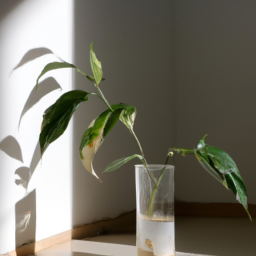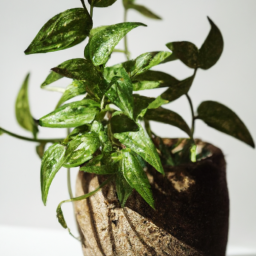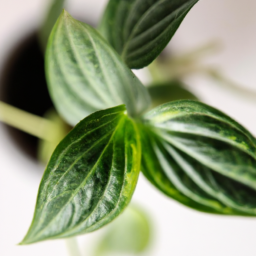
Have you ever wondered how indoor plants survive without sunlight? It’s a common question among plant enthusiasts and those who are new to caring for indoor greenery. While it may seem counterintuitive, many indoor plants have adapted to thrive in low-light conditions, making them perfect companions for homes and offices with limited access to natural sunlight. In this blog post, we will explore the fascinating ways in which indoor plants manage to survive and even thrive without direct sunlight. So, if you’re curious about the secrets behind their resilience and want to learn how to keep your indoor plants healthy and happy, keep reading!
The Importance of Light for Indoor Plants’ Survival
Indoor plants bring life and beauty to our homes, but have you ever wondered how they survive without direct sunlight? While sunlight is crucial for photosynthesis, the process by which plants convert light energy into chemical energy, there are ways for indoor plants to thrive even in low-light conditions. In this article, we will explore the importance of light for indoor plants’ survival and provide you with a step-by-step guide on how they can adapt to limited sunlight.
Understanding Photosynthesis and Light
Photosynthesis is the driving force behind a plant’s growth and survival. It is the process by which plants use sunlight, carbon dioxide, and water to produce glucose (sugar) and oxygen. This glucose serves as the plant’s energy source, allowing it to grow, develop, and produce flowers or fruits.
Light is essential for photosynthesis because it provides the energy needed to convert carbon dioxide and water into glucose. Sunlight contains various wavelengths, including red and blue light, which are the most important for photosynthesis. These wavelengths are absorbed by pigments called chlorophyll, found in plant cells, which then initiate the process of photosynthesis.
However, not all indoor plants have the same light requirements. Some plants, such as succulents and cacti, have adapted to survive in arid environments with intense sunlight. On the other hand, there are plants that naturally grow in shaded areas, such as ferns and certain types of ivy. These shade-loving plants have evolved to thrive with less sunlight, making them ideal choices for indoor gardening.
Adapting Indoor Plants to Low-Light Conditions
While sunlight is the best source of light for indoor plants, there are ways to ensure their survival in low-light conditions:
1. Choose the Right Plant: As mentioned earlier, some plants are better suited for low-light environments. When selecting indoor plants, consider species that are known for their ability to thrive in shade or low-light conditions. Examples include snake plants (Sansevieria), pothos (Epipremnum aureum), and ZZ plants (Zamioculcas zamiifolia).
2. Provide Adequate Indirect Light: Even though they don’t require direct sunlight, indoor plants still need light to survive. Place them near windows where they can receive indirect light throughout the day. North-facing windows often provide the most consistent and gentle light, while east or west-facing windows may provide a few hours of direct morning or afternoon light, respectively.
3. Supplement with Artificial Light: In rooms with limited natural light, you can supplement the lack of sunlight by using artificial light sources. LED grow lights are a popular choice as they emit the necessary wavelengths for photosynthesis. Position the lights a few inches above the plants and keep them on for 12-16 hours a day, replicating the natural day-night cycle.
4. Rotate Your Plants: Indoor plants tend to grow towards the light source, causing uneven growth. To ensure balanced growth, rotate your plants every few weeks to expose all sides to light. This will prevent them from leaning or stretching towards the light, maintaining a more compact and healthy appearance.
5. Monitor Watering and Humidity: In low-light conditions, plants may require less water as their growth slows down. Overwatering can lead to root rot, so it’s important to let the soil dry out slightly between waterings. Additionally, maintaining a suitable humidity level by misting the leaves or using a humidifier can help compensate for the lack of natural humidity in indoor environments.
6. Avoid Temperature Extremes: Indoor plants generally prefer temperatures between 60-75°F (15-24°C). Avoid placing them near drafts, heating vents, or air conditioning units, as these can cause temperature fluctuations that may stress the plants.
By following these steps, you can create a suitable environment for indoor plants to thrive, even without direct sunlight. Remember to regularly assess your plants’ health and make adjustments as needed. With proper care and attention, your indoor garden will bring beauty and freshness to your living space.

Alternative Light Sources for Indoor Plants
Indoor plants bring life and beauty to our homes, but what happens when they don’t receive enough sunlight? While sunlight is the primary source of energy for plants, there are alternative light sources that can help indoor plants survive and thrive. In this article, we will explore different options for providing light to your indoor plants and discuss their effectiveness.
Natural Light vs. Artificial Light
Before delving into alternative light sources, it’s important to understand the difference between natural light and artificial light. Natural light, as the name suggests, comes from the sun and provides a full spectrum of wavelengths that plants need for photosynthesis. Artificial light, on the other hand, is produced by human-made sources such as fluorescent bulbs, LED lights, and grow lights. While natural light is ideal for plants, artificial light can be a suitable substitute when sunlight is limited.
Now, let’s explore some of the most common alternative light sources for indoor plants:
1. Fluorescent Lights
Fluorescent lights are widely available, affordable, and emit a broad spectrum of light that is beneficial for plants. They come in different types, including cool white, warm white, and full spectrum. Full spectrum fluorescent lights closely mimic natural sunlight and are the best choice for indoor plants.
When using fluorescent lights, it’s important to consider their distance from the plants. Most indoor plants require light intensity equivalent to 10,000 to 20,000 lux. Position the fluorescent lights about 6 to 12 inches above the plants and adjust the height as the plants grow. Keep the lights on for 12 to 16 hours a day to simulate daylight conditions.
2. LED Lights
LED lights have gained popularity in recent years due to their energy efficiency and long lifespan. They are available in a variety of colors, including red, blue, and white. Red and blue LED lights are most effective for plant growth, as they correspond to the wavelengths absorbed by chlorophyll.
When using LED lights, it’s crucial to select the right color temperature. For vegetative growth, choose lights with a higher proportion of blue light (around 6500K). For flowering and fruiting, opt for lights with a higher proportion of red light (around 2700K). LED lights should be placed 12 to 24 inches above the plants and kept on for 12 to 16 hours a day.
3. Grow Lights
Grow lights are specifically designed for indoor gardening and provide plants with the necessary light spectrum for optimal growth. They are available in various types, such as high-pressure sodium (HPS) lights, metal halide (MH) lights, and ceramic metal halide (CMH) lights.
HPS lights emit a warm, orange-red light that is ideal for flowering and fruiting plants. MH lights produce a cool, blue light that is suitable for vegetative growth. CMH lights combine the benefits of both HPS and MH lights, providing a balanced spectrum for all stages of plant growth.
When using grow lights, follow the manufacturer’s instructions regarding the recommended distance and duration of light exposure. Generally, grow lights should be positioned 12 to 36 inches above the plants and kept on for 12 to 16 hours a day.
Remember to monitor your plants closely when using alternative light sources. Observe their growth, color, and overall health to ensure they are receiving adequate light. Additionally, consider rotating the plants periodically to ensure all sides receive equal light exposure.
In conclusion, while indoor plants thrive with natural sunlight, alternative light sources can help them survive without direct sunlight. Fluorescent lights, LED lights, and grow lights are all viable options for providing the necessary light spectrum for plant growth. By understanding the different types of light sources and their requirements, you can create an indoor environment that supports the health and vitality of your beloved plants.

Adaptations of Indoor Plants to Low Light Environments
Indoor plants have the remarkable ability to survive and even thrive in low light environments. This is due to their unique adaptations that allow them to make the most of the limited light available. In this article, we will explore the fascinating ways in which indoor plants have evolved to survive without direct sunlight.
1. Increased Chlorophyll Efficiency
Chlorophyll is the pigment responsible for capturing sunlight and converting it into energy through a process called photosynthesis. Indoor plants have adapted to low light conditions by increasing their chlorophyll efficiency. They produce more chlorophyll molecules per unit of light, allowing them to absorb and utilize even the smallest amount of available light.
Furthermore, indoor plants often have darker green leaves compared to their outdoor counterparts. This is because darker pigments can absorb light more effectively, enhancing the plant’s ability to carry out photosynthesis in low light environments.
Additionally, some indoor plants have developed specialized chloroplast structures that can optimize the absorption of light. These structures, known as grana, are tightly packed stacks of chlorophyll-containing membranes. By maximizing the surface area available for light absorption, grana enable indoor plants to thrive in low light conditions.
2. Efficient Use of Available Light
Indoor plants have also evolved mechanisms to efficiently use the limited light that reaches them. One such adaptation is the ability to adjust their leaf orientation to capture as much light as possible. Some plants have leaves that naturally tilt towards the light source, ensuring that they receive optimal exposure.
Furthermore, indoor plants often have larger and broader leaves compared to outdoor plants. This increased leaf surface area allows them to capture more light and maximize the amount of energy they can produce through photosynthesis.
In addition to optimizing light capture, indoor plants have developed mechanisms to minimize light loss. They may have waxy or hairy leaves that help to trap and retain moisture, preventing excessive evaporation. This not only conserves water but also reduces the reflection of light, allowing the plant to make the most of the available photons.
3. Efficient Resource Allocation
Indoor plants have adapted their resource allocation strategies to cope with low light environments. They prioritize the allocation of resources towards growth and maintenance rather than reproduction. By focusing on growth, indoor plants can increase their leaf surface area and enhance their ability to capture light.
Furthermore, indoor plants have developed efficient nutrient uptake mechanisms. They have evolved specialized root structures, such as fine root hairs, that increase the surface area for nutrient absorption. This enables them to extract essential minerals and nutrients from the soil more efficiently, compensating for the reduced energy gained from photosynthesis in low light conditions.
Another adaptation is the ability to store energy reserves. Indoor plants allocate resources towards building up energy reserves in their stems and roots. These reserves can be utilized during periods of low light, ensuring the plant’s survival even when photosynthesis is limited.
In conclusion, indoor plants have evolved a range of fascinating adaptations that allow them to survive and thrive in low light environments. By optimizing chlorophyll efficiency, efficiently using available light, and allocating resources strategically, these plants have found innovative ways to make the most of the limited light they receive. So, if you’re looking to bring some greenery into your home or office, rest assured that there are plenty of indoor plants that can flourish even in the absence of direct sunlight.
Let’s wrap up what we learned
Indoor plants have always fascinated me with their ability to thrive in low-light conditions. It’s mind-boggling to think that they can survive without direct sunlight, which is essential for photosynthesis. But how do they do it? Well, it turns out that nature has equipped these plants with some clever adaptations to make the most of the limited light available indoors.
One of the key strategies indoor plants employ is their ability to adapt to low-light environments. They have evolved to have larger, more efficient chloroplasts that can capture and utilize light more effectively. Additionally, some indoor plants have developed broader leaves to maximize the surface area available for light absorption. These adaptations enable them to make the most of the limited light they receive, ensuring their survival even in dimly lit corners of our homes and offices. But that’s not all! Indoor plants also have the remarkable ability to adjust their metabolic processes to compensate for the reduced light. They slow down their metabolism and growth rate, conserving energy and resources to sustain themselves in low-light conditions. This adaptation allows them to survive for extended periods without sunlight, making them perfect companions for those of us with less-than-ideal lighting situations in our indoor spaces.
Here are some questions from our readers:
Q1: Can indoor plants survive without sunlight?
A1: Yes, indoor plants can indeed survive without direct sunlight. While most plants require some amount of light to carry out photosynthesis, there are several types of plants that are well adapted to low-light conditions and can thrive indoors.
Q2: How do indoor plants survive without sunlight?
A2: Indoor plants adapt to low-light conditions by using different strategies. Some plants have larger leaves that help them capture more light, while others have variegated or lighter-colored foliage that maximizes light absorption. Additionally, certain plants are more efficient at converting available light into energy, allowing them to survive with less sunlight.
Q3: What are some low-light indoor plants that can survive without direct sunlight?
A3: There are several popular low-light indoor plants that can thrive in the absence of direct sunlight. Some examples include snake plants (Sansevieria), pothos (Epipremnum aureum), ZZ plants (Zamioculcas zamiifolia), and peace lilies (Spathiphyllum). These plants have adapted to survive in the understory of forests where they receive minimal sunlight.
Q4: How can I provide enough light for indoor plants that don’t receive sunlight?
A4: If you have indoor plants that require low light, you can provide them with artificial light sources. LED grow lights or fluorescent lights are excellent options for supplementing the light needs of indoor plants. Place the lights close to the plants and ensure they receive light for around 12-16 hours a day to mimic natural daylight.
Q5: Is it possible to overexpose indoor plants to artificial light?
A5: Yes, it is possible to overexpose indoor plants to artificial light. Just like sunlight, plants need a balance of light and darkness to thrive. Too much light exposure can lead to leaf burn or stress the plant. It’s important to follow the recommended light duration for each specific plant species and monitor their response to ensure they’re receiving the optimal amount of light.

James Wong is a renowned ethnobotanist, plant scientist, and local television presenter. With a passion for demystifying plant science, he is known for translating complex botanical concepts into practical advice for everyday plant enthusiasts. James’s expertise spans from traditional gardening to cutting-edge plant technologies, making his insights accessible and informative.


